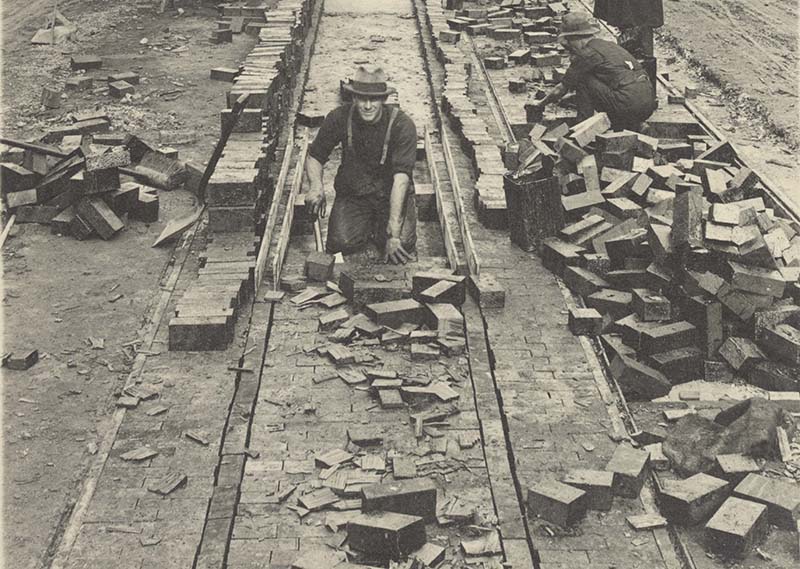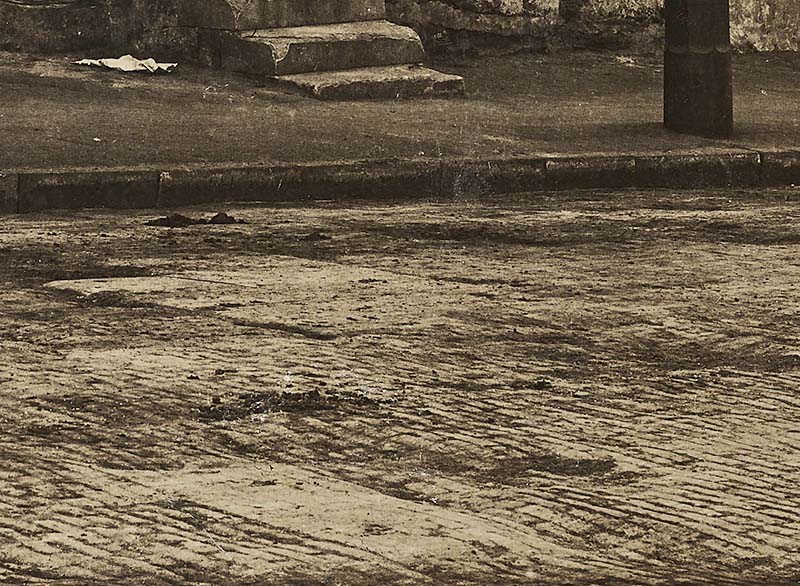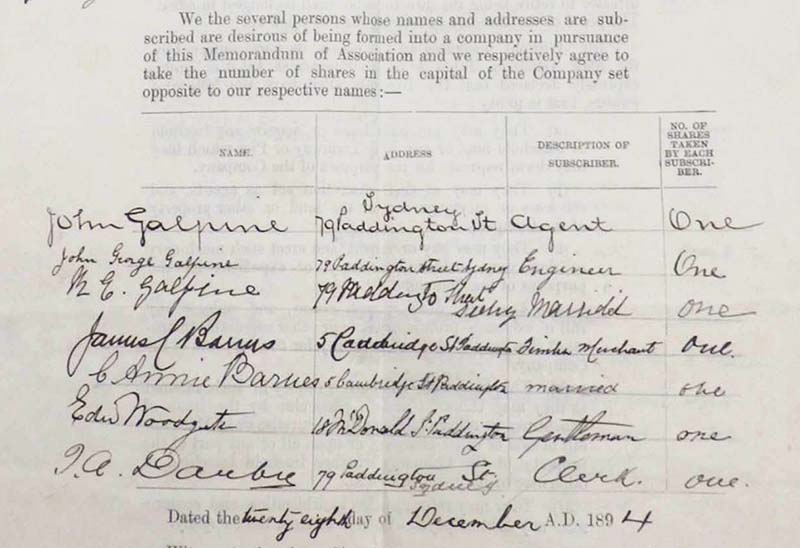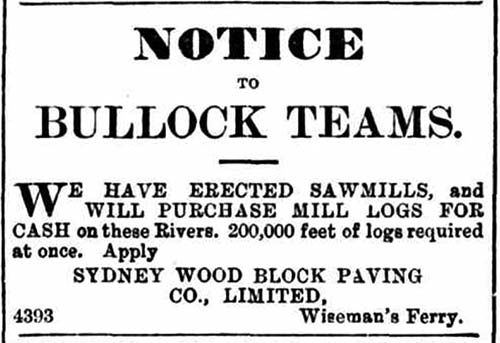
The Sawmill of the
Sydney Wood Block Paving Company
Operated by John Galpine and James C. Barnes at Wisemans Ferry
Singleton Mills homepage > The Wisemans Ferry Mills > The saw-mill of the Sydney Wood Block Paving Co.
A sawmill was briefly operated by the Sydney Wood Block Paving Company in the 1890s near Wisemans Ferry, NSW.
Our research suggests that the Sydney Wood Block Paving Company, and another very similar enterprise, the Colonial Hardwood Company, may both have been linked to the early history of Bailey's Mill on Dillons Creek.
Wood Block Paving
Wooden hardwood or softwood blocks, laid in a regular pattern onto a concrete and stone foundation, and coated with tar, could be used as a road surface material.

Above: wood block paving being laid in Sturt Street, South Melbourne, VIC, in 1925 during the construction of a tramway. Photograph: State Library Victoria.
In the 1800s, wood block paving was favoured for road building, as it provided a smoother surface than irregular cobblestones, and horse traffic was reportedly quieter on a wood block paved road. The surfaces could, however, be slippery if wet or icy, and the blocks could tend to rot or to become dislodged by flooding. [1]
A detailed report in 1894 by Sydney's City Surveyor, R. W. Richards, stated that wood block paving began in Sydney in 1880. A test pavement using eight different kinds of wood, was initially laid in King Street, between George and Pitt Streets. Sections of other Sydney streets were then paved. The timbers that were finally recommended, based on the results from the past 14 years, were blue gum, red gum, black butt, tallowwood, mahogany and turpentine. [2]
Another report said that by 1894, more than 77 acres [31 hectares] of road in Sydney had already been laid with wood blocks. It further commented:
"The city of Sydney is heavily committed to the use of wood blocks as a material for the pavement of the roadways." [3]

Above: a wood block paved road surface at the corner of George and King Streets in Sydney in 1920. Photograph source: City of Sydney Archives.

Above: a worn wood block paved road surface in Kent Street, Sydney in about 1908. Photograph source: City of Sydney Archives.
Wood blocks continued to be used for street surfacing in Sydney until the 1930s. [4]
A display showing what a wood-block-paved road surface looked like can be seen outside 55 George Street, Sydney.
The Sydney Wood Block Paving Company
The Sydney Wood Block Paving Company of Wisemans Ferry began in an ambitious way. [5] In 1894, their advertisement stated, "200,000 feet of logs required at once: red gum, blackbut [blackbutt]) and mahogany". [6] However, due to financial difficulties, the mill only operated from November 1894 to March 1896.
Company documents held in the NSW Archives reveal that the managing director of the Sydney Wood Block Paving Company Limited was John Galpine. When the company was first established on 28 December 1894, the shareholders were:
-- John Galpine,
-- John George Galpine (son of John Galpine),
-- R. E. Galpine (first wife of John Galpine),
-- James C. Barnes,
-- C. Annie Barnes (wife of James Barnes),
-- Edward Woodgate (father of Catherine Barnes), and
-- J. A. Darby (?) (clerk of a Galpine business in Sydney).

Above: the shareholders signatures on the Sydney Wood Block Paving Company Memorandum of Association in 1894.
John Fletcher Galpine (ca. 1844-1919) was born in York, UK. In various UK records, he was listed as a draper's assistant or as a carpet warehouseman. John married Rose Emma Smith in London in 1865. John George Galpine, their son, was born in UK in 1861.
The Galpine family came to Australia between 1881 and 1994. In Sydney, John Galpine's occupations included restaurant keeper, agent and merchant. In 1894, John's son, John George Galpine, was described as an engineer. After Rose Galpine died in 1896, John Galpine married Catherine Lowe Follett (the daughter of Gilbert Follett) in 1898.
James Charles Barnes (1861 - before Dec 1924) was born in Tasmania. He married Catherine Annie Woodgate in 1885 at Dubbo, NSW. James' occupation in 1894 was a timber merchant. He became the manager of the Sydney Wood Block Paving Company mill at Wisemans Ferry.
The Sydney Wood Block Paving Company Mill
We have found no record of this mill's precise location so far, other than that it was located near Wisemans Ferry. [7] However, our background research suggests that the Sydney Wood Block Paving Company mill may have been built on the site where Bailey's Mill later stood, on land that was originally granted to James Singleton.
An agreement on 14 January 1895 between John Galpine and the Sydney Wood Block Paving Company Mill reveals that:
-- the sawmill stood on about two acres of leasehold land at Wisemans Ferry;
-- the buildings included a sawmill and a general store;
-- John Galpine had operated the business of the sawmill and store on that site for some time before the agreement;
-- the value of the building plant, machinery and stores at Wisemans Ferry was about £1300.
The Sydney Wood Block Paving Company set up their mill at Wisemans Ferry in late 1894:
"The Sydney Wood Block Paving Company have set up mills at Wiseman's Ferry, and are going extensively into the business." [5]

Above: On 5 November 1894, the Sydney Wood Block Paving Company required bullock teams "at once" for their sawmill at Wisemans Ferry. Source: The Maitland Daily Mercury.
The mill commenced work in about February 1895. [7] However, just one month later, the mill was already facing difficulties:
"The work at the saw-mill owned by the Wood-and-block-paving Company, of Sydney, seems to be at a stand-still at present on account of not having sufficient logs to go on with. It is expected that it will be eight or ten days before the mill will be in full swing." [8]
In 1895, a financial dispute arose between John Galpine and the mill manager, James Barnes. In a court action, John Galpine claimed that James Barnes owed him about £91 from the mill proceeds. James Barnes replied, "There had been no profits, but instead a loss". [9] In November 1895, the business was wound up by the company members. [10] Nevertheless, in March 1896, a report stated that the company had restructured and intended to resume operations. [11]
According to NSW Archives records, another company called the Colonial Hardwood Company was set up in 1896. Certain features of this company's operation suggest it may have had links to the Sydney Wood Block Paving Company's mill.
Intriguingly, a report on a flood at Wisemans Ferry in 1898 noted that: "Some fifty logs left by the old saw-mill were floated away by the flood." [12] Could this have been the final chapter in the story of the Sydney Wood Block Paving Company mill?
Do you know any further details about |
The Wisemans Ferry mill of the Sydney Wood Block Paving Company is an interesting example of the many sawmills established in regional NSW during the 1800s. This Company proposed to supply huge quantities of timber for road paving in Sydney. Substantial mill buildings and machinery were set up and the Company employed local people for a short time. Then, when insufficient timber could be found to supply the mill, the Company was wound up.
Researched by Anne and Les Dollin
References
1. Nicholson pavement. Wikipedia: en.wikipedia.org/wiki/Nicolson_pavement Accessed 28 January 2024.
2. The Sydney Morning Herald, 23 March 1894.
3. The Brisbane Courier, 13 April 1894.
4. Telling The Rocks Stories – Historical Interpretation in The Rocks. thedirton.therocks.com/2010/03/telling-rocks-stories-historical.html Accessed 28 January 2024.
5. Windsor and Richmond Gazette, 17 November 1894.
6. Windsor and Richmond Gazette, 10 November 1894.
7. The Daily Telegraph, 7 February 1895.
8. Windsor and Richmond Gazette, 9 March 1895.
9. The Sydney Morning Herald, 15 August 1895.
10. New South Wales Government Gazette, 3 December 1895, Issue 807, Page 7865.
11. Windsor and Richmond Gazette, 28 March 1896.
12. Windsor and Richmond Gazette, 26 February 1898.
Further Reading on Mills at Wisemans Ferry
• The Wisemans Ferry Mills • Tidal flour mill at Laybury Creek Mill • Bailey's Sawmill • The Colonial Hardwood Company sawmill • Otto Olson's sawmill